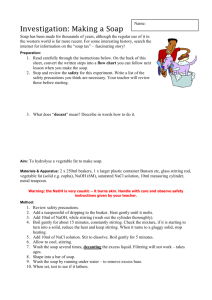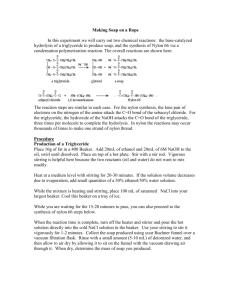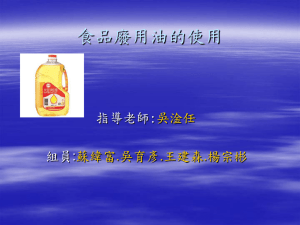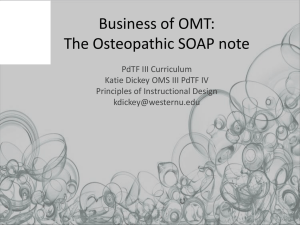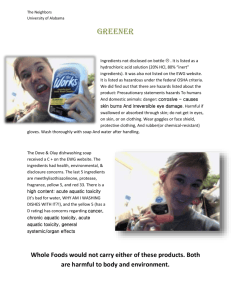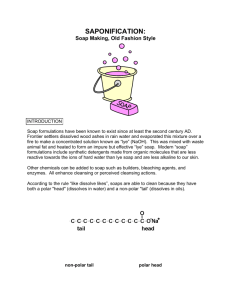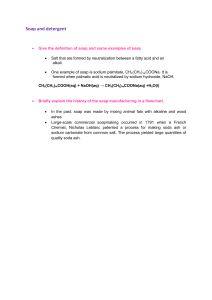File
advertisement
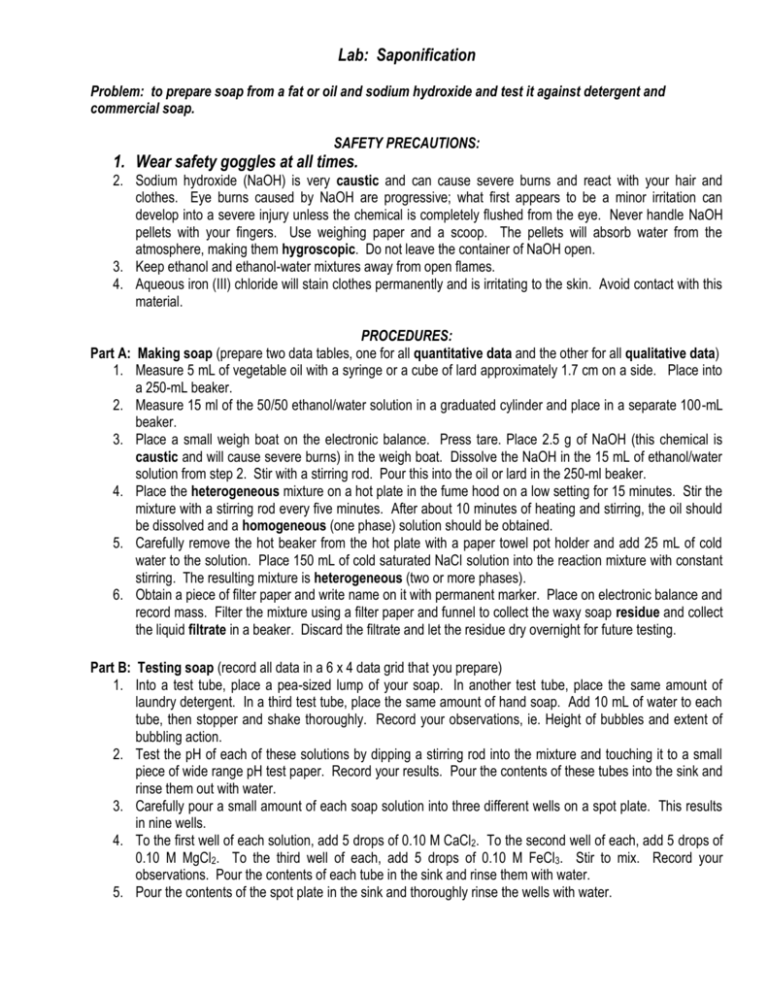
Lab: Saponification Problem: to prepare soap from a fat or oil and sodium hydroxide and test it against detergent and commercial soap. SAFETY PRECAUTIONS: 1. Wear safety goggles at all times. 2. Sodium hydroxide (NaOH) is very caustic and can cause severe burns and react with your hair and clothes. Eye burns caused by NaOH are progressive; what first appears to be a minor irritation can develop into a severe injury unless the chemical is completely flushed from the eye. Never handle NaOH pellets with your fingers. Use weighing paper and a scoop. The pellets will absorb water from the atmosphere, making them hygroscopic. Do not leave the container of NaOH open. 3. Keep ethanol and ethanol-water mixtures away from open flames. 4. Aqueous iron (III) chloride will stain clothes permanently and is irritating to the skin. Avoid contact with this material. Part A: 1. 2. 3. 4. 5. 6. PROCEDURES: Making soap (prepare two data tables, one for all quantitative data and the other for all qualitative data) Measure 5 mL of vegetable oil with a syringe or a cube of lard approximately 1.7 cm on a side. Place into a 250-mL beaker. Measure 15 ml of the 50/50 ethanol/water solution in a graduated cylinder and place in a separate 100-mL beaker. Place a small weigh boat on the electronic balance. Press tare. Place 2.5 g of NaOH (this chemical is caustic and will cause severe burns) in the weigh boat. Dissolve the NaOH in the 15 mL of ethanol/water solution from step 2. Stir with a stirring rod. Pour this into the oil or lard in the 250-ml beaker. Place the heterogeneous mixture on a hot plate in the fume hood on a low setting for 15 minutes. Stir the mixture with a stirring rod every five minutes. After about 10 minutes of heating and stirring, the oil should be dissolved and a homogeneous (one phase) solution should be obtained. Carefully remove the hot beaker from the hot plate with a paper towel pot holder and add 25 mL of cold water to the solution. Place 150 mL of cold saturated NaCl solution into the reaction mixture with constant stirring. The resulting mixture is heterogeneous (two or more phases). Obtain a piece of filter paper and write name on it with permanent marker. Place on electronic balance and record mass. Filter the mixture using a filter paper and funnel to collect the waxy soap residue and collect the liquid filtrate in a beaker. Discard the filtrate and let the residue dry overnight for future testing. Part B: Testing soap (record all data in a 6 x 4 data grid that you prepare) 1. Into a test tube, place a pea-sized lump of your soap. In another test tube, place the same amount of laundry detergent. In a third test tube, place the same amount of hand soap. Add 10 mL of water to each tube, then stopper and shake thoroughly. Record your observations, ie. Height of bubbles and extent of bubbling action. 2. Test the pH of each of these solutions by dipping a stirring rod into the mixture and touching it to a small piece of wide range pH test paper. Record your results. Pour the contents of these tubes into the sink and rinse them out with water. 3. Carefully pour a small amount of each soap solution into three different wells on a spot plate. This results in nine wells. 4. To the first well of each solution, add 5 drops of 0.10 M CaCl2. To the second well of each, add 5 drops of 0.10 M MgCl2. To the third well of each, add 5 drops of 0.10 M FeCl3. Stir to mix. Record your observations. Pour the contents of each tube in the sink and rinse them with water. 5. Pour the contents of the spot plate in the sink and thoroughly rinse the wells with water. Data: Table 1: Quantitative data Material Quantity Table 2: Qualitative data Procedure Table 3: Testing Soap pH Lab soap Observations bubble height Ca+2 results Mg+2 results Fe+3 results Detergent Coast soap Discussion Questions: 1. Write the chemical reaction for the saponification in this lab. Indicate which substances are the reactants and which are the products, using an arrow to separate reactants and products. 2. Draw a molecule of water, and one of hexane. Why is one molecule polar and one nonpolar? 3. Draw the molecular structure of a typical soap molecule. Describe the molecule in terms of its dual polarity and its structural affinity both grease and water. 4. How does the pH of the soap solution that you prepared compare with the pH of the solutions of laundry detergent and hand soap? Which of these would have the harshest effect on the skin? Why? (Remember that pH = 7 is neutral, less than 7 = acidic, more than 7 = basic; extreme pH values of 1-2 or 13-14 are caustic) 5. What did you observe when the metal ions Ca+2, Fe+3 and Mg+2 (ions very present in well water) were added to the soap or detergent? What will happen clothes, skin and hair when being washed with soap and water that contains many metal ions? Explain. 6. Describe how soap molecules work to remove grease from your hair. Draw and label a diagram of grease, soap molecules and micelle formation. Conclusion:
